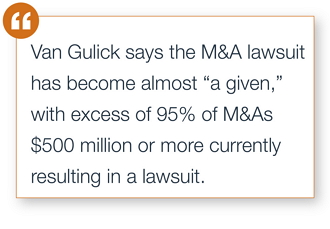Insuring directors and officers through M&A and IPO events.
Corporate transactions
including mergers and acquisitions (M&A) and initial public offerings (IPO)
bring necessary capital and resources to a growing company. But, these
transactions can also be the impetus for legal recourse - a significant
liability for the company’s directors and officers.
“Mergers and acquisitions
can be fairly contentious and not all shareholders agree that it is in their
best interest for Company A to buy Company B,” said Jeff Van Gulick, Senior
Vice President, Commercial Lines Practice Leader, HUB International. “An even
greater bone of contention can be ‘inadequate consideration'. While the board
has done their due diligence, some shareholders may still argue they didn’t do
enough – that they should have received more money from the transaction.”
 Van Gulick says the M&A
lawsuit has become almost “a given,” with excess of 95% of M&As $500
million or more currently resulting in a lawsuit.[1]
Van Gulick says the M&A
lawsuit has become almost “a given,” with excess of 95% of M&As $500
million or more currently resulting in a lawsuit.[1]
As a result, D&O
insurance responds largely to defense costs only, never paying the difference
in stock prices. And in the last few years, these cases have prompted D&O
insurers to put specific M&A retentions into their policies.
Retention, or self-insured retention, refers
to the amount of money an insured business is responsible for paying first in
the event of a claim before the insurance kicks in.
Retentions make insurance coverage more affordable by reducing the premium
costs.
These retentions, which typically cost insured businesses a
minimum of $1 million to $1.5 million, come in two forms – a standard M&A
retention, which carries a broad classification and could apply to any M&A lawsuit
including a breach of fiduciary responsibility or breach of contract, and a
merger objection retention, which is targeted specifically to an M&A inadequate
consideration suit.
Unlike an auto deductible,
D&O policies feature self-insured retentions, or SIRs, that are to be paid
upfront before the policy kicks in. A policy with one million dollar merger
objection retention, for example, would pick up the claim only after the
retention had been paid out and until policy limits have been exhausted.
“You want the correct type
of M&A retention to be utilized, applying to as few circumstances as possible,”
said Van Gulick. “It’s up to the broker involved to ensure that the correct
exclusionary language is put into the policy.”
Do IPOs also necessitate an additional
policy?
In 2014, IPO
activity grew substantially until it reached its current rate - the highest in
the last six years. The greatest liability for D&Os during an IPO comes
from the prospectus document that discloses the company’s risks and financials
to the public. The information in this document creates absolute liability for
a company’s directors and officers and is subject to a three-year statute of
limitations.
Traditional D&O coverage
will include prospectus liability although a stand-alone prospectus liability
policy can be purchased as well. “If you stick with a traditional D&O
policy you’ll want your broker to negotiate adequate endorsements to cover IPO &
SOX exposures, including prospectus liability,” said Van Gulick.
Buying the
right limits to cover the business beyond the IPO can be another challenge, as
businesses that purchase limits predicated off only the IPO could find
themselves without adequate coverage. When in this situation, sit down with a
broker to navigate the benchmarking that will ultimately help determine what
limits will provide the necessary coverage.
Which D&O coverage option is a good fit?
In general there are three
types of D&O coverage – Traditional, Side A and Independent director policies.
Traditional
coverage will indemnify the company, its officers and directors.
Side
A coverage covers a company’s directors and officers, but not the business
itself. Big companies with lots of capital that aren’t worried about insuring
the corporation will buy Side A insurance. Side A policies will cover
situations where the business can’t indemnify its directors and officers.
Independent
director liability (IDL) policies will cover a company’s
directors exclusively. In a typical D&O claim, the directors might be
concerned about D&O limits left to cover them under a traditional policy.
IDL coverage enables companies to attract more experienced, high-powered directors
to their board.
What limit level is
appropriate?
Getting the limits right for
your D&O policy is important and will require an experienced broker to explore
as many indicators as possible on your behalf. Brokers should use a variety of different
benchmarking metrics - including your litigation history and your company’s
market capitalization - to model potential losses and determine optimal D&O
policy limits.
Do you have the right international coverage?
Companies that conduct business
internationally may no longer be able to use their global master insurance
program abroad. Countries like Brazil, for example, are now requiring D&O policies
to be purchased locally in order to pay out funds to local executives should a
D&O claim arise. These new edicts have already left directors and officers
working in foreign subsidiaries high and dry in cases where the company hasn’t
purchased local coverage.
Contact your HUB commercial
lines broker to establish the right D&O coverage and limits for your
businesses’ exposures when navigating M&As and IPOs.
[1]
Cornerstone Research. Securities Class Action Filings: 2014 Year in Review.